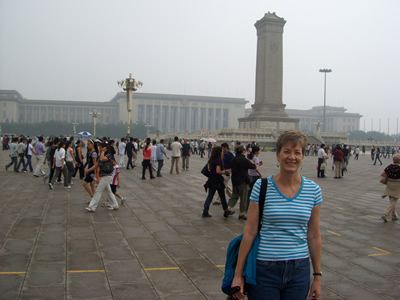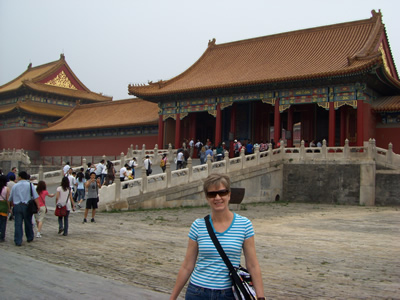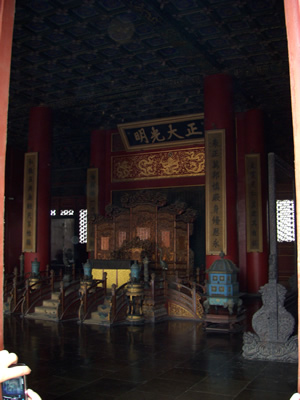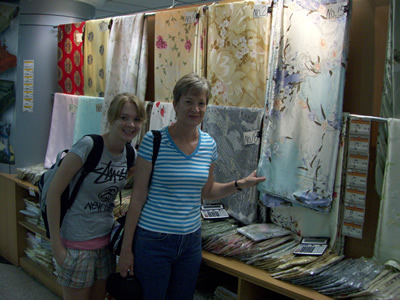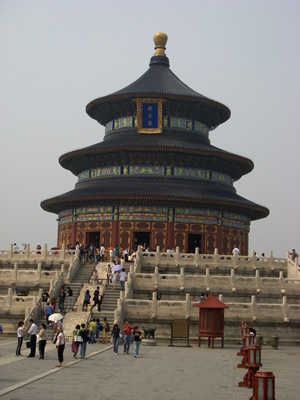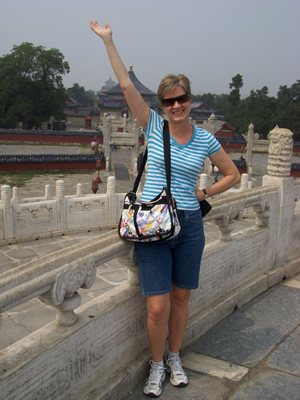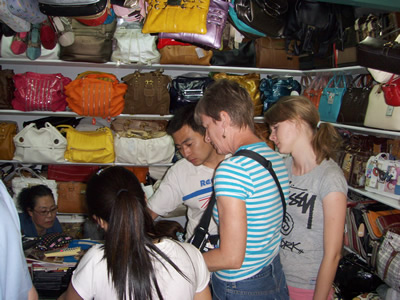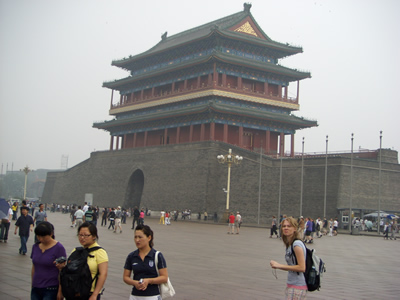China pt 2 - Beijing
Our driver actually gave us a ride to Tiananmen Square even though it was only a block away. That would be our only short ride on the entire trip. The square is directly south of the Forbidden City, separated by Tiananmen Gate on it's north side. A long north/south axis runs for many kilometers from far south of the square through to Forbidden City and beyond to Jin Shang Park. This was the way to approach the emperor and if you weren't very important, you might have to start all the way from the beginning. The square is almost exactly 100 acres which makes it the largest open-air urban square in the world. Most people in the west know it for the protests against the government and subsequent violence which occured there in 1989. In China it is famous as the place where Mao Zhedong gave the speech that announced the formation of the People's Republic in 1949. There is a huge picture of Mao hanging on the Gate of Heavenly Peace where he stood and addressed the crowd. Mao sometimes spoke to huge rallies in the square and crowds of half a million people were common. The square only reached it's present size under the People's Republic and was actually a walled courtyard during imperial times.
On our way to the square there were about two minutes of drizzle. This was enough to convince me that I should borrow an umbrella from the concierge at the hotel. In this way I was able to make it stop raining, and we had good weather for the entire rest of the trip. As long as I was carrying an umbrella.
The square is always busy. Early in the morning local people come to walk and do their Tai Ching exercises. Throughout the day it is filled with tourists, both foreign and domestic. Local people walk around and fly kites. Hawkers sell their merchandise. And security guards are conspicuous (I suspect the government wants no more incidents). It is surrounded by busy streets and when we were there it was lined with tour buses. Walking around the square is a fairly long hike. In the center is the Monument to the People's Heroes. It is dedicated to the one million Chinese soldiers who died during WWII and the Civil War which followed. In the southern section is Mao Zhedong's tomb. There was a long queue of people to go in and pay their respects which Bruce told us was usual. At the very southern end of the square is the Qianmen Gate, the largest and certainly one of the most impressive gates in the city. Both it and the Tiananmen Gate at the north end were built in the 1400's by the Ming emperors, but both were damaged or destroyed several times and then rebuilt or restored.
After our walk around the square we entered the Forbidden City. This is a walled off palace area built 600 years ago by the Ming dynasty when they moved the capitol of China to Beijing from Nanjing. (Beijing means "Northern Capital".) Hundreds of thousands of people worked for thirteen years to build the new capital and Forbidden City. It was where the emperors of the Ming and Qing dynasties lived. Common people and foreigners were not allowed to enter the palace area (hence the name, duh!). Only the emperor, his wives and girlfriends (lots) and the eunichs who attended to them were allowed in the palace. It has been a museum since 1924 although it was damaged somewhat when the People's Republic was established. Most of it was preserved during the Cultural Revolution though because Premier Zhou Enlai sent an army battalion to occupy and protect it. 980 buildings still survive today and it was declared a UNESCO world heritage site in 1987. There is currently a large effort underway to restore the site. It is the largest preserved collection of ancient wooden buildings in the world. The Beijing government is also trying to restore the area around the Forbidden City and is not even allowing any buildings taller than the palace to be built in the vicinity.
We entered the Forbidden City via the Gate of Heavenly Peace through the main entrance right below Chairman Mao's picture. It seemed like most of the billion people in China were trying to enter at the same time. Once through the gate though the crowd dispersed, there was just so much space. The Forbidden City is a series of courtyards separated by large gates. It eventually leads to the inner palace where the emperor and his household lived.
I had several impressions. The first is that the architecture is really beautiful. All of the buildings and gates are traditional Chinese imperial architectural style. The roofs and eaves on all the buildings are yellow which is the color of the emperor. No other buildings in the city were allowed to have yellow roofs or trim. Only the palaces were allowed to be decorated in yellow. The second impression, which forms as you keep walking and walking (and walking and walking and walking) is just how huge the place is. It just keeps going and going. It is almost a kilometer from the south gate to the north gate.
It was not possible to go into any of the buildings although a few of them had open windows that you could peek through and take photos. And at the end was the imperial gardens which were very pretty. There is a huge rock outcrop in the gardens that was supposedly made from rock fragments from all over China to remind the emperor of the extent of the empire. We finally came out of the north gate and could see the huge moat and wall topped with archery towers that surrounds the Forbidden City. Across the road from the north gate is Jin Shang Park. In 1644 a peasant uprising was successful and captured Beijing. To avoid capture the last Ming emperor killed all of his wives and children and then escaped to the hill in Jin Shang Park and hung himself. Although the rebellion was put down by a Ming general it allowed the Manchus to get through the Great Wall, conquer China and establish the Qing dynasty.
After a long morning and a lot of walking we were ready for lunch. Our driver picked us up and took us to a nearby restaurant. The menu had all sorts of noodle dishes so we ordered a vegetable and noodle dish that looked harmless. After a while they brought us a small plate of green vegetables. I thought it was a pretty small salad but I busied myself with trying to eat it with my chopsticks. Not easy. After a few minutes the server brought out our noodle bowls. At that time he was kind enough to show me that what was left of my "salad" was supposed to be poured over the noodles and mixed in with them and the sauce. Oh well. An important qualification for foreign travel is that you have to accept that some of the time you are going to look really dumb. At least the waiter didn't roll his eyes too much. Once I got it right the lunch was pretty good, although I was the only one of us who finished.
After lunch we went to a silk factory. A lady there gave us a tour that showed how the silk cocoons were processed and the thread was extracted. It seemed like a lot of work. They made just about everything you could imagine out of silk. Obvious stuff like clothes of course. But also bedclothes, including silk comforters. They had a wide selection of carpets and painted silk wall hangings. We ended up buying a comforter and a set of sheets and pillow cases. They were able to compress it into an incredibly small package that actually fit into our luggage (although it took up almost a whole suitcase by itself). But I kept thinking that I would be carrying it through the airport and the whole thing would give way and just explode. I bet that would get the attention of the security guards.
After our shopping break it was back to serious sightseeing. We went to the Temple of Heaven. This is in a large park a short distance southwest of Tiananmen Square. Twice a year the emperor would lead important ceremonies there and make sacrifices for a good harvest and other prayers. As the "Son of Heaven" he was able to make special requests on behalf of the nation. These were an important symbol in establishing the power of the emperor to rule.
We entered by the north gate. The gate had three entrances just like all of the gates in the Forbidden City. There the center entrance and the center path on the main north/south axis were reserved for the emperor. But at the Temple of Heaven, even the emperor did not walk down the center path. He used the right entrance and all other officials used the left entrance. First is the large marble Round Altar. This was the most important point for the ceremonies and was where the emperor offered up sacrifices. In the center is a stone that the Chinese believed was the center of the earth (I guess they will have to argue that with the Greeks who claimed that the center of the universe was at the Temple of Delphi). While Sandy did a BAM shot, Shannon got talked into posing for pictures with several Japanese tourists. And Sandy and I can't even get her to pose for our pictures. From there a long walk across the Red Step Bridge slowly rises a few feet to symbolize the climb to heaven. Next is the Imperial Vault of Heaven, which was used to store ceremonial gear. Finally we reached Qianan Dian, or Hall of Prayer for Good Harvests. This is a beautiful temple which has become the symbol of the city of Beijing.
After the Temple of Heaven Sandy had a special request. She wanted to go to the famous (or infamous) Silk Market where she could look for knockoffs. She was interested in finding a (not) Coach purse. Bruce came along with us to help negotiate. This was quite a place. It used to be a street market but it was moved into a four story building - six if you count the two basements. Each floor is packed with tiny stalls that sell everything you can imagine. The leather goods were in one of the basements so that's where we headed. Sandy and Bruce talked to several of the shopkeepers and looked through their catalogs to see if Sandy could find the purse she wanted. As she picked out purses the shopkeeper would send someone off somewhere (who knows where?) and five minutes later he would come back with more purses. After two stalls and about an hour, Sandy found a purse that she really liked although it was not a (not) Coach bag. Clear? She got it for a really good deal - only 700 yuen (about $100USD) plus another purse plus a wallet. In the process Bruce picked up a new "Louis Vutton" wallet. It gave me a chance to explain to him the expression "now you're stylin'". On the way home Sandy had a scare when the strap came off - she thought it was broken already. But it turned out it had a snap that had just come loose, so everything was fine.
While Sandy was doing her negotiating I wandered around for a few minutes just to explore the place. That was dangerous. The merchants were very aggressive. As you walked by each stall they all called to you to come in and look. That wasn't bad, but a few even grabbed you as you walked by. Not cool. But from their perspective I can understand. Trying to differentiate your little stall, with pretty much the same goods as all the other stalls in the row, is quite a marketing challenge!
That was a long day. We were dropped off at the hotel and had a quiet Chinese dinner there of pizza and pasta.
